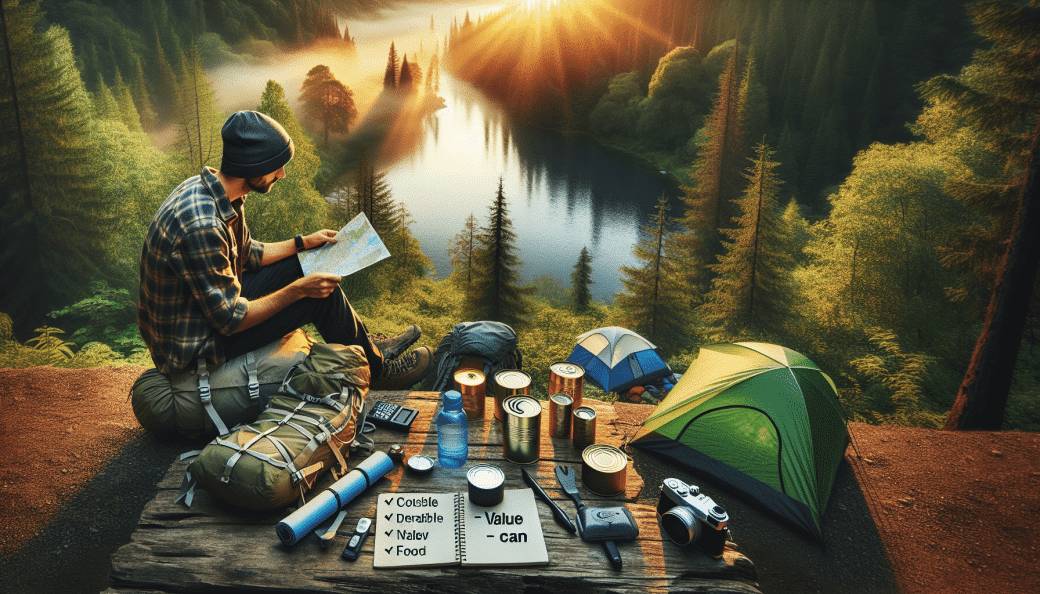Looking to lighten the load on your next backpacking adventure? Streamlining Your Pack: Mastering Lightweight Backpacking Techniques is here to help. This article provides you with practical tips and tricks for reducing the weight of your backpack, allowing you to trek comfortably and efficiently. From choosing the right gear to packing strategically, we’ve got you covered. So, grab your hiking boots and get ready to embark on an unforgettable journey with a lighter load.

Choosing the Right Gear
When it comes to lightweight backpacking, choosing the right gear is crucial to ensure a comfortable and enjoyable experience on the trail. There are a few considerations to keep in mind when selecting your gear. First and foremost, weight is a key factor. Look for lightweight options that won’t add unnecessary pounds to your pack. Additionally, durability is important, as you want gear that will withstand the rigors of the trail. Finally, think about the specific needs of your trip and choose gear that is suitable for the conditions you’ll be facing.
In terms of essential gear for lightweight backpacking, there are a few key items that should be at the top of your list. A lightweight backpack is essential for carrying all of your gear, so be sure to choose one that fits well and distributes weight evenly. A lightweight tent or hammock system is also important for providing shelter at camp. Additionally, a sleeping bag or quilt that is specifically designed for lightweight backpacking will keep you warm and comfortable without weighing you down. Finally, don’t forget about a reliable stove and cookware for preparing meals on the trail.
When selecting lightweight gear, there are a few tips to keep in mind. First, do your research and read reviews from other backpackers to get a sense of how well a particular item performs in the field. Look for gear that is made from high-quality materials and is specifically designed to be lightweight. Additionally, consider multi-purpose items that can serve multiple functions, as this will help you save weight and space in your pack. Finally, try out your gear before hitting the trail to ensure that it fits well and functions properly.
Packing Strategically
Once you have your gear selected, it’s important to pack strategically to maximize space and weight distribution in your backpack. Start by organizing your pack in a way that makes sense to you. Keep frequently used items easily accessible, such as your water bottle or rain jacket. Consider using packing cubes or dry bags to keep similar items together and make them easier to find.
Another important aspect of packing strategically is maximizing space and weight distribution in your pack. Pack heavier items closer to your back and towards the center of your pack to keep the weight balanced and reduce strain on your body. Use compression straps or bungee cords to secure bulky items and keep them from shifting inside your pack. Additionally, consider using a backpack with external pockets or attachment points to further optimize storage space.
There are also packing techniques that can help streamline your pack and save space. One technique is rolling your clothes instead of folding them, which can help reduce wrinkles and save space in your pack. Another technique is using your backpack’s empty spaces, such as stuffing socks or other small items inside your shoes. Finally, consider using lightweight and compact gear whenever possible to further optimize space in your pack.

Minimizing Clothing and Layers
When it comes to clothing and layers, minimizing is key to keeping your pack light and efficient. Choose versatile clothing items that can be worn in a variety of conditions and for multiple days. Look for materials that are lightweight, quick-drying, and moisture-wicking to keep you comfortable on the trail. Consider packing multi-purpose items, such as a lightweight jacket that can double as a pillow or a pair of convertible pants that can be shorts or pants.
Layering is also important for lightweight backpacking, as it allows you to adjust your clothing to changing conditions. Start with a base layer that is breathable and moisture-wicking to keep you dry and comfortable. Add insulating layers, such as a fleece or down jacket, for extra warmth when needed. Finally, top it off with a waterproof and breathable outer layer to protect yourself from rain and wind.
When it comes to laundry on the trail, there are a few tips to keep in mind. First, pack lightweight and quick-drying clothing that can be easily washed and dried overnight. Consider using a lightweight laundry kit that includes a small amount of biodegradable soap and a mesh bag for washing your clothes. Finally, plan your laundry days strategically to ensure that you have clean clothes when you need them.
Efficient Food and Water Planning
Planning your food and water needs efficiently is essential for lightweight backpacking. Start by calculating how much food and water you will need for the duration of your trip. Consider factors such as the length and difficulty of the trail, your own personal metabolism, and any specific dietary restrictions or preferences.
When it comes to trail food, choose lightweight and nutritious options that are easy to prepare. Look for dehydrated meals, energy bars, and dried fruits and nuts that provide a good balance of calories and nutrients. Consider portioning your meals in advance to save on weight and packing space.
Water filtering and treatment options are also important considerations. Look for lightweight and compact water filters or purification tablets that can safely remove bacteria, viruses, and parasites from natural water sources. Consider using hydration bladders or collapsible water bottles to save on weight and space, as they can be easily rolled up when empty.

Navigation and Safety Considerations
Navigating with minimal gear is an important skill for lightweight backpacking. Make sure to bring a topographic map and compass, and practice using them before your trip. Consider using a GPS device or smartphone app as a backup navigation tool, but remember to bring extra batteries or a power bank. Additionally, familiarize yourself with the trail before setting out, and pay attention to trail markers and signs along the way.
Planning ahead for emergency situations is crucial for your safety on the trail. Pack a lightweight first aid kit that includes essential items such as bandages, antiseptic wipes, and pain relievers. Consider taking a wilderness first aid course to learn important skills for responding to injuries and emergencies in the backcountry. Finally, make sure to let someone know your itinerary and expected return date before you head out.
Essential safety gear for lightweight backpacking includes items such as a whistle, headlamp or flashlight, and a lightweight emergency blanket. These items can provide crucial assistance in case of an emergency or unexpected overnight stay on the trail. Consider carrying a lightweight personal locator beacon (PLB) or satellite messenger for emergency communication in remote areas.
Streamlining Campsite Setup
Setting up your campsite efficiently can help save time and energy at the end of a long day on the trail. Choose a lightweight shelter that suits your needs, such as a lightweight tent, hammock, or tarp. Practice setting up your shelter before your trip to familiarize yourself with the process and optimize your setup time.
Optimizing your sleep system can also contribute to a lighter pack. Choose a lightweight sleeping bag or quilt that is suitable for the expected temperature range. Consider using a sleeping pad that is lightweight and has a high warmth-to-weight ratio. Finally, try out different pillow options, such as a lightweight inflatable pillow or a stuff sack filled with clothing, to find the most comfortable and lightweight option for you.
When it comes to efficient campsite setup, there are a few tips to keep in mind. Choose a campsite that is already well-established to minimize the impact on the natural environment. Consider using a lightweight camping stove instead of building a campfire, as it is more efficient and leaves less impact on the surroundings. Finally, practice leave no trace principles by packing out all of your trash and properly disposing of human waste.
Minimizing Waste and Environmental Impact
Lightweight backpacking provides an opportunity to minimize waste and reduce your environmental impact on the trail. Follow the principles of leave no trace to ensure that you are enjoying the outdoors responsibly. This includes packing out all of your trash, properly disposing of human waste, and minimizing disturbances to wildlife and vegetation.
Reducing waste and packaging is another way to minimize your impact. Consider repackaging food items into lightweight and reusable containers to reduce the amount of packaging waste you generate. Choose bulk or single-serve options whenever possible to minimize packaging waste. Finally, consider using lightweight and compact gear that has minimal packaging and is made from sustainable materials.
Sustainable practices on the trail go beyond waste reduction. Consider using a lightweight and rechargeable headlamp instead of disposable batteries. Use biodegradable soap for washing dishes and yourself, and disperse dishwater away from water sources. Finally, practice leave no trace principles by respecting the natural environment and leaving it as you found it.
Training and Physical Preparation
Preparing your body for lightweight backpacking is important to ensure that you can handle the physical demands of the trail. Start by gradually increasing your endurance and strength through regular cardiovascular exercise and strength training. This can include activities such as hiking, running, cycling, and weightlifting.
Training techniques for endurance and strength can help you build the necessary stamina and muscle strength for long days on the trail. Consider incorporating interval training and hill repeats into your cardio workouts to improve your cardiovascular fitness. Additionally, focus on exercises that target your core and lower body muscles, as these are the areas that bear the brunt of the weight when backpacking.
Stretching and injury prevention are also important aspects of physical preparation. Incorporate stretching exercises into your pre and post-hike routine to improve flexibility and reduce the risk of injury. Consider using a foam roller or massage ball to release tight muscles and promote faster recovery. Finally, listen to your body and take rest days as needed to allow for proper recovery and prevent overuse injuries.
Essential Skills for Lightweight Backpacking
In addition to physical preparation, there are a few essential skills that can enhance your lightweight backpacking experience. Orienteering and navigation skills are important for staying on track and finding your way in the backcountry. Practice using a map and compass, and consider taking a navigation course to improve your skills. Additionally, learn how to read and interpret topographic maps, as well as understand common trail signs and markers.
First aid and emergency response training is also crucial for lightweight backpacking. Learn basic first aid skills, such as treating cuts, sprains, and insect bites. Consider taking a wilderness first aid course to learn more advanced skills for responding to emergencies in remote areas. Finally, make sure to carry a well-stocked first aid kit and know how to use its contents.
Campsite and trail etiquette is another important aspect of lightweight backpacking. Follow the principles of leave no trace and minimize your impact on the natural environment. Respect other campers and hikers by keeping noise levels down and giving them plenty of space. Finally, be considerate of wildlife and observe from a safe distance, never feeding or approaching them.
Final Thoughts and Recommendations
Embracing the freedom of lightweight backpacking can enhance your outdoor adventures and allow you to explore more of the natural world. Remember that lightening your pack not only lightens your load but also lightens your spirit, allowing you to fully enjoy the beauty and serenity of the trail.
When it comes to product recommendations for lightweight gear, there are a few standout options worth considering. For lightweight backpacks, the Osprey Exos and the Granite Gear Crown2 are popular choices among backpackers. For tents, the Big Agnes Fly Creek HV UL and the Nemo Hornet are well-regarded for their lightweight construction. Therm-a-Rest and Enlightened Equipment offer high-quality sleeping bags and quilts specifically designed for lightweight backpacking.
In conclusion, mastering lightweight backpacking techniques involves carefully choosing the right gear, packing strategically, minimizing clothing and layers, efficient food and water planning, navigation and safety considerations, streamlining campsite setup, minimizing waste and environmental impact, training and physical preparation, essential skills, and embracing the freedom of lightweight backpacking. By following these tips and recommendations, you can embark on unforgettable adventures with a lighter and more efficient pack. As the saying goes, “Lightening your pack not only lightens your load but also lightens your spirit.”



